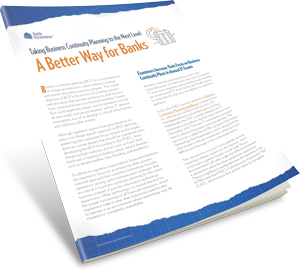Business Continuity Planning for Banks Books

Simplify Business Continuity Planning for Your Bank with a Structured and Repeatable Approach

A bank's Business Continuity Plan (BCP) has evolved to become the crucial blueprint for guiding an institution through the process of recovering from a business outage. Examiners are looking at these plans closely to verify that banks not only have the right plan in place, but are also able to successfully execute it. Many banks choose to keep continuity planning in-house and manually develop their plans. With increased levels of regulatory scrutiny, innovative bankers are embracing technology to make BCP a more efficient and streamlined process.
Many institutions take a qualitative approach to continuity planning, and this requires coordinating meetings between various stakeholders to come to consensus decisions. To create a more efficient BCP process, bankers should be looking to implement an application that will help their financial institution follow the FFIEC-prescribed process and facilitate the collaborative elements of BCP. The end result should include a complete and comprehensive plan that meets regulators' expectations and equips the financial institution to handle and recover from possible disasters in a timely and efficient manner.
Enterprise Modeling – The First Step to a Successful Business Continuity Plan
Each bank has a unique operating model based on its specific services, organization, processes, and technologies. Before an institution can figure out how to sustain or recover operations, it must first have a thorough understanding of all the functions and processes that make up those operations. At Safe Systems, we refer to this information gathering step as Enterprise Modeling. This involves breaking the institution into departments (aka Functional Units) and determining the team members responsible for each of these areas. Each department is responsible for one or more business processes, and each of those processes is comprised of multiple functions.
Enterprise modeling can streamline the BCP process and give bankers the ability to assign those most knowledgeable with their department's operations the task of developing the recovery plan. It is difficult (if not impossible) for a single individual to have all of the knowledge required to recover operations for every department and process. Involving additional people, if not managed properly, can create an even more complex process. By starting with an Enterprise Modeling step, the institution will directly map required functions to those individuals responsible for accomplishing those functions. Organizing the process in this manner will simplify the gathering of business recovery information from each department head, ensure that all processes are addressed, and help institutions develop a more accurate assessment of their risks.
Automating Your Bank's Manual BCP Processes
Business Continuity Planning is cyclical and assessments should be revisited regularly. Automating repetitive portions of BCP process eliminates the need to update cumbersome spreadsheets, and can carry over information from time-consuming data gathering and reporting activities completed in previous assessments. An automated BCP solution will help guide financial institutions through the entire process of BCP — from assigning department heads, documenting key activities, services, and applications, assessing critical recovery times, testing procedures, and staying on top of key updates related to the plan.
It is crucial to ensure the BCP will meet regulatory scrutiny while providing an efficient and simplified process for the institution. Community banks, in particular, should have a business continuity plan that is easy to understand, easy to use, and developed specifically for their institution. An automated application should provide the necessary structure to keep banks on track, but should also allow for customization as each institution sees fit.

Taking Business Continuity Planning to the Next Level:
A Better Way for Banks
Learn how examiners are increasing their focus on BCP, the risks involved in relying on a single individual, and better ways to develop your plan.

At Safe Systems, we understand that BCP can be a very time consuming and stressful process for banks. To help streamline this process, we have developed a Business Continuity Plan application, BCP Blueprint, to help facilitate and automate the BCP process. This application helps financial institutions move from a pieced together set of recovery procedures to a cohesive enterprise-wide approach for continuity planning. The end result will include a complete and comprehensive plan that meets regulators' expectations and equips financial institutions to better respond when disaster strikes. For more information please download our complimentary white paper, Taking Business Continuity Planning to the Next Level: A Better Way for Banks, by clicking the image above.
Be the first to hear about regulatory guidance and industry trends
Source: https://www.safesystems.com/blog/2016/10/simplify-business-continuity-planning-for-your-bank-with-a-structured-and-repeatable-approach/
Belum ada Komentar untuk "Business Continuity Planning for Banks Books"
Posting Komentar